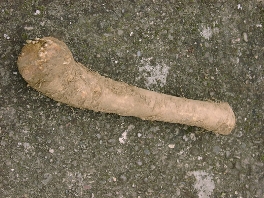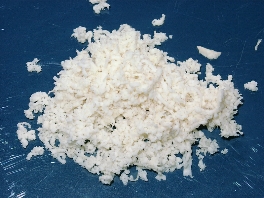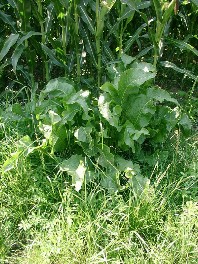 Horseradish is wellknown as a refinement of meat dishes.
Horseradish is wellknown as a refinement of meat dishes.
Only few people know, that it has strong remedial effects.
The sharp root of the horseradish helps against all kinds of infectious diseases and also against pain. The horseradish can even destroys viruses of the flu.
In the fall and winter, one should always have a horseradish root in the refrigerator or basement to have it available in case of a cold or a flu.
Medicinal Uses
- Antibacterial
- Strengthening the immune system
- Colds
- Flu
- Sinusitis
- Coughs
- Bronchitis
- Asthma
- Tonsillitis (angina )
- Fever
- Mucus-dissolvent
- Causing perspiration
- Diuretic
- bladder- and kidney inflammation
- Urinary stones
- Neuralgic complaints
- Rheumatism
- Gout
- Muscle pain
- loss of appetite
- Digestive weakness
- Flatulences
- Constipation
- Vitamin C lack
- Scurvy
- Headaches
- Menses promoting
- Insect stings
- Dental pain
Information
| Used Parts: | Root |
| Substances: | Vitamins, essential oil, mustard oils, Allyl mustard oil, Allicine, Glucosinolate, Sinigrine, Gluconasturtiine, minerals, Flavone, Quercetine, Kämpferol, Asparagine, Arginine, organic sulfur |
| Time to collect: | September til March |
Methods
 Best, the horseradish root is used freshly.
Best, the horseradish root is used freshly.
Wash and peel only the area of the root that you want to use.
Then grate the root and use it immediately, because the essential oils evaporate very fast (within a quarter of an hour.)
The grating of the horseradish root is already a kind of therapy for the sinuses because the sharp essential oil rises up to the nose and releases tears and secretion from the nose muscous membranes. If you do not need this treatment, then you can put on diver eye glasses in order to escape the sharp essential oils.
Right after grating you can eat the horseradish or you can add it to sauces or other dishes.
Against insect stings, you can put the fresh grated horseradish to the affected place.
Also you can put the horseradish to places of dental pain until the sharpness disappears.
Horseradish poultice
Horseradish poultice helps against lumbago, sciatica or persistent cough, headaches and neuralgic pain.- You should grease the affected place with oil, ointment or vaseline. (Against coughs, treat the chest area, against headaches treat the neck.)
- Then the horseradish that was grated freshly will be put on a cotton piece of cloth.
- Put this cloth with the horseradish side to the skin on the body place.
- The poultice remains on the skin until it begins to burn.
- Then remove the poultice, clean the skin and put ointment on it if required.
Horseradish wine
With horseradish wine, you can expel bladder stones or force the menses. In addition, horseradish wine is strongly diuretic.- Cut eight to ten thin horseradish pieces.
- Give these horseradish pieces into a glass.
- Pour wine over the horseradish pieces.
- Let this wine for all day long stand (min. eight hours.)
- Drink the horseradish wine.
Horseradish regimen
A horseradish regimen is suitable in order to push the immune system.Particularly in the cold time, a horseradish regimen helps in order to prevent colds. If the cold is already around, one can alleviate it with a horseradish regimen.
- Take one each tea spoon of horseradish in the morning and in the evening.
- Prefer horseradish that was freshly grated but if this one is unavailable, you can also use horseradish from a glass.
- Take the horseradish at least two weeks long.
Keeping horseradish
in farms horseradish is keeped in damp sand. Thus he endures the whole winter.If you have a cool basement you can fill sand into a bucket and put the horseradish roots there.
If not, you can wrap the root into damp paper-cloths and put the horseradish roots into the refrigerator. There, the horseradish lasts for weeks.
Plant description
 Originally, the horseradish comes from Eastern Europe and Southern Europe.
In Central Europe it is cultivated, but is also found savage.
Originally, the horseradish comes from Eastern Europe and Southern Europe.
In Central Europe it is cultivated, but is also found savage.
The horseradish prefers a profound ground.
The rootstock has a form like a kind of cudgels. He gets for one half meters long and over four centimeters in the diameter. On the outside, the root is bright-yellow and inside whitish.
In the springtime, the horseradish root will expel big leaves.
The stalk of the blossom, where also smaller leaves grow, comes later.
As of May, the little white blossoms are blossomming.
In the fall until spring the horseradish root is collected.
